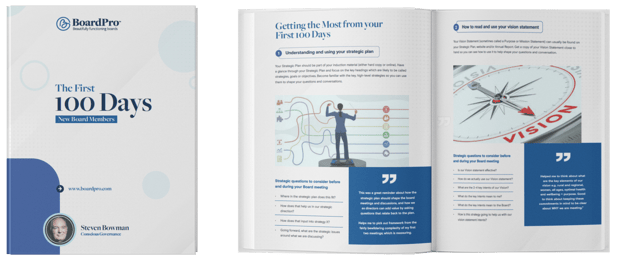Unveiling the Four Key Elements of an Effective Board Induction Program
The day you join the leadership team on a board of directors is the day you become liable for the decisions of the board. Preparing for this responsibility, ensuring you are confident, enthusiastic and ready for the challenges that lay beyond the first board meeting, is the function of a well-designed board induction program. This is a crucial process which routinely suffers from a breakdown in implementation. No matter how experienced (or not) you are as a Director, the first 100 days sets the scene for your tenure.
The four key elements
There are four key elements that create a high performing Board Induction Program. These key elements need to be embedded into the Induction program
- It is mandatory
- The process and outcomes are formally monitored by the Governance committee or any equivalent committee
- Mentors are assigned to each new Director, with a changeover of mentors after 6 months
- The Induction program is at least 12 months in duration
Getting the Most from your First 100 Days
1. Understanding and using your strategic plan
Your Strategic Plan should be part of your induction material (either hard copy or online). Have a glance through your Strategic Plan and focus on the key headings which are likely to be called strategies, goals or objectives. Become familiar with the key, high-level strategies so you can use them to shape your questions and conversations.
Strategic questions to consider before and during your Board meeting
- Where in the strategic plan does this fit?
- How does that help us in our strategic direction?
- How does that input into strategy X?
- Going forward, what are the strategic issues around what we are discussing?
"This was a great reminder about how the strategic plan should shape the board meetings and discussions, and how we as directors can add value by asking questions that relate back to the plan. Helps me to pick out framework from the fairly bewildering complexity of my first two meetings; which is reassuring."
2. How to read and use your vision statement
Your Vision Statement (sometimes called a Purpose or Mission Statement) can usually be found on your Strategic Plan, website and/or Annual Report. Get a copy of your Vision Statement close to hand so you can see how to use it to help shape your questions and conversation.
Download our special white paper and learn how to gain the most value from your board members during the first 100 days
Strategic questions to consider before and during your Board meeting
- Is our Vision statement effective?
- How do we actually use our Vision statement?
- What are the 204 key intents of our Vision?
- What do the key intents mean to me?
- What do the key intents mean to the Board?
- How is this strategy going to help us with our vision statement intents?
"Helped me to think about what are the key elements of our vision e.g. rural and regional, women, all ages, optimal health and wellbeing + purpose. Good to think about keeping these commitments in mind to be clear about WHY we are meeting.”
3. How to use your board policies
Find a list of your board policies, and the policies themselves, Understanding and using your board policies enables you to fulfil your legal obligations and provides a framework for how you and your organisation should and must function. If in doubt, ask your CEO for more details on your policy framework.
Strategic questions to consider before and during your Board meeting
- Which policies have been referenced or used in the past?
- Do I understand this policy?
- Does this policy comply with relevant legislation?
- How does this add strategic value to our organisation?
"Made me realise that I was expecting to gradually come to terms with Board policies throughout the year BUT realising after our last Board meeting that with the organisations 3 year review process means I won’t see a lot of the policies in the year ahead. So now thinking I will ask which 3 policies are key starting point as a new Board member."
4. Extracting strategic insights from your financial reports
Find your profit and loss statement (sometimes called income and expenses statement), your balance sheet and your cash flow (some organisations may not have a cashflow, check with your CEO). Refer to them to start putting into practice some of the questions explained below.
"I really enjoyed this one - quite smart to actually chase the reason for variances - it’s almost like being on the lookout for issues even before they become apparent."
Strategic questions to consider before and during your Board meeting
- What's the reason for the variance between what was expected and what our reports tell us?
- Given this reason for variance, what are the strategic implications
- What's not working? What do we need to do about it?
- What questions should we be asking that we haven't asked yet?
Balance sheet:
- What are the key ratios your balance sheet is telling you?
- What has changed and why?
- What are the strategic implications?
Cash Flow:
- What's our cash flow likely to be like on a three-month rolling basis?
- Are we keeping to our budget, or do we expect to fall below our forecasts?
- What are the strategic implications for us and what, if anything, do we need to start doing about it?
Key rations:
- What are the acceptable ranges for our ratios?
- What has changed and what do we need to consider long term?
5. Understanding and using your Risk Management Plan
"Am aware of basic risk management processes and data for projects and organisations. Appreciated the encouragement to think laterally about the opportunities within risk."
Strategic questions to consider before and during your Board meeting
- What are the 2 or 3 key risks we should receive reports on, and focus on leveraging for opportunity?
- What is our risk appetite and how do staff use that to triage what they bring to us as Directors?
6. Tips on what to look for in your constitution, rules and by-laws
Your constitution is the contract you have that provides the rules for how the organisation should conduct its business. All Directors should be familiar with the key clauses in the constitution.
These could include:
- What are our dispute mediation / Conflict resolution clauses?
- How is voting carried out at the Board meeting?
- What are the terms of my position?
Strategic questions to consider before and during your Board meeting
- Are we carrying out everything required of us based on our constitution?
- Have there been any legal changes that must be reflected in our constitution?
7. Reflection on Legal Responsibilities
As a director, you have certain legal responsibilities that you must be aware of, and put into action. There are 3 duties of directors at law that are common in most countries. Check in with your CEO regarding any particular circumstances or detail you may need to know as a Director in your organisation.
1. The Duty of Care: to act as an ordinary, prudent person would in a similar set of circumstances. This requires diligent, attentive, informed participation.
2. The Duty of Loyalty: to act in good faith, in the best interests of the organisation.
3. The Duty of Obedience: to act to ensure the organisation operates in keeping with the laws and rules governing its formation and status and in accordance with its own bylaws and mission.
"Useful to reflect on examples of duty of care, loyalty and obedience, led me back to another look at our Rules of Incorporation"
Check in with your CEO regarding any particular circumstances or detail you may need to know as a Director in your organisation.
8. Getting the most from your induction - Mentoring
Make sure you get the most from your Director mentoring program. This program should fast-track any answers to questions you might have as a new Board member before or after meetings, and facilitate getting to know other Board members, senior management and stakeholders.
"Really nice idea, was never suggested on any of the boards I have been. But definitely will apply it to a board which I chair."
Strategic questions to consider before and during your Board meeting
- New Board member's questions regarding how the Board works, about individuals or about Board actions:
- Any problems with the new Board member's conduct that do not meet Board expectations:
- Goals and major areas of interest as a new Board member:
- New Board member's satisfaction with the induction as well as his or her ability to participate at Board and Committee meetings.
Summary
There are 3 key areas that need to be a focus of any new Director in their first 100 days on a Board.
1. Make the most use of the Induction program through questioning, meeting people and utilising the mentoring for greater insight.
2. Understand how the Board uses various resources such as strategic plan, risk management plan, financial reports, vision statement, and use these resources to help shape powerful questions and conversations.
3. Be willing to contribute questions and discussion from your first Board meeting onwards.
These behaviours will assist in further strengthening the Board culture where robust discussions, strategic viewpoints, risk issues and a continuous focus on making the choices that create the future for the communities you serve, are the hallmarks of your high performing Board.

If you're looking for a tool to streamline your Board processes, check out BoardPro - an all-in-one software solution designed specifically for Boards and busy CEOs!
Schedule a demo with our team today and begin to experience a whole new way of meeting.
Share this
You May Also Like
These Related Stories
%20(1).png)
How to Onboard New Board Members

10 Keys To Network Your Way to Your Next Board Position



